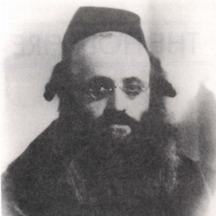Exploring history can be a complicated experience. On one hand, you can rediscover the rich art and culture of your ancestors, which is what we do on our Jewish cruises. On the other hand, exploring the past includes exploring the hardships and tragedies of earlier times, from expulsions to pogroms.
World War 2 was a turning point in history, and for many Jews who lived through that harrowing time, it seemed that the dawn was too far away. However, despite the dire circumstances, many stepped up and fought against the darkness, through acts of resistance or words charged with resolve. Such was the life of Rabbi Shapira, whose personal tragedies could not impede his words of holy fire.
Life and Persistence
 Rabbi Shapira was born in Grodzisk, Poland in 1889, son of the leading Hasidic leader of the country in that time. Kalonymus’ father, Elimelekh, died when he was three, but despite this loss, he continued to lead a life of spiritual purpose. He became the rabbi of the small town of Piaseczno, spreading Hasidic teachings in a time when secularization was common in Poland. He would later move to Warsaw, setting up one of the largest yeshivas in that city and settling down with his wife Rachel Chaya Miriam. They had two children together.
Rabbi Shapira was born in Grodzisk, Poland in 1889, son of the leading Hasidic leader of the country in that time. Kalonymus’ father, Elimelekh, died when he was three, but despite this loss, he continued to lead a life of spiritual purpose. He became the rabbi of the small town of Piaseczno, spreading Hasidic teachings in a time when secularization was common in Poland. He would later move to Warsaw, setting up one of the largest yeshivas in that city and settling down with his wife Rachel Chaya Miriam. They had two children together.
Poland was invaded by the Nazis during World War 2. His son died in the initial bombing of Warsaw, which was then taken over. The Warsaw Ghetto was the largest of its kind, used to imprison and persecute Jews from all over Poland, a place where they could be corralled and deported to concentration camps. Later on, his own daughter would be deported. Rabbi Shapira lived in this ghetto, and from the documents that he wrote down, he saw the faith of his people falter.
Despite his personal suffering and the dire circumstances of the people under his care, Rabbi Shapira forged on, offering guidance and wisdom to the people who were as tired and harrowed as he was. He continued to write and compile literature during this time, and his most famous work, the Aish Kodesh (“Holy Fire”), was a compilation of his various speeches and discourses, words that he used to inspire and give hope.
When the Warsaw Ghetto Uprising was crushed, he was taken to a work camp. After a period of time in as a factory worker, Rabbi Shapira was killed alongside many others, on the 3rd of November, 1943.
Holy Fire Across Generations
Rabbi Shapira’s works were hidden in a milk container, along with many other Hebrew and Yiddish Manuscripts. His work gave a glimpse into the tribulations of a pious individual, looking for answers to help comfort others as they were facing persecution together. Despite everything, he persisted, and his Aish Kodesh would light up the path of the faithful for years and years to come.
As we’ve said before, our Jewish heritage tours seek to rediscover the culture and works of our predecessors. While the events at the Warsaw Ghetto are saddening, the stalwart resolve of the Jews who lived there are worth remembering.
